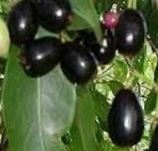How This Helps
Syzygium jambolanum is a tree commonly called the black plum, native to India. Its seeds are used to extract the medicinal tincture which is rich in alkaloids which help normalize blood sugar levels in diabetics. The most important active components that exert the anti-hyperglycemic action are jambosine and glycoside jambolin or antimellin. It has not been clear which alkaloid exerts what action, but collectively these halt the diastatic conversion of dietary starch into sugar. [2]
See: Diabetes: Type II research studies for holistic treatments
Science and Research
Type 2 diabetes is a major endocrine disorder characterized by hyperglycemia or raised blood sugar levels. Apart from genetic factors, obesity, family history, mental stress and sedentary lifestyle contribute to the development of diabetes. Homoeopathy offers medicines with substantial glucose lowering properties making it a much preferred system of medicine to treat diabetes. It aids the mind to combat stress that can help minimize the psychological element as well as attend to the physical component of diabetes.
Extensive research has revealed that elevated glucose for a long period causes protein glycation leading to advanced glycation end products – the major cause of different diabetic complications including retinopathy (eyes), neuropathy (nerves), and nephropathy (kidneys). [3] Syzygium jambolanum has the pharmacological potential of interrupting this process of glycation thereby protecting the organs against the injurious effects of diabetes. [4]
See: High Blood Sugar, weakness and over weight
Homoeopathic Remedy:
History reveals that in the pre-insulin era when there were no specific modalities of treatment, Syzygium jambolanum was used extensively to treat hyperglycemia. Syzygium jambolanum has been found to reduce blood sugars as well as sugar in the urine rapidly without any adverse reactions. [1]
Expert Opinion:
In addition to the glucose lowering potential in Syzygium jambolanum, the ellagic acid content of the seeds also contributes in lowering blood pressure by around 34.6%. [5] A blessing in disguise!
Recommended Dosage:
25 drops of the mother tincture diluted in about half a cup of water should be taken 3 times a day for at least 3 months for the desired results.
Note: For patient specific treatments and dosage, always consult with a homeopathic doctor before beginning treatment.
See: Diabetic Retinopathy research studies for holistic treatments
References:
1. Scientific validation of the antidiabetic effects of Syzygium jambolanum DC (black plum), a traditional medicinal plant of India. Baliga MS, Fernandes S, Thilakchand KR, D’souza P, Rao S. J Altern Complement Med. 2013 Mar;19(3):191-7. doi: 10.1089/acm.2011.0752. Epub 2012 Oct 2. Review.
2. Observational study of homeopathic and conventional therapies in patients with diabetic polyneuropathy. Pomposelli R, Piasere V, Andreoni C, Costini G, Tonini E, Spalluzzi A, Rossi D, Quarenghi C, Zanolin ME, Bellavite P. Homeopathy. 2009 Jan;98(1):17-25. doi: 10.1016/j.homp.2008.11.006.
3. Advanced Glycation End Products and Diabetic Complications. Varun Parkash Singh, Anjana Bali, Nirmal Singh, and Amteshwar Singh Jaggi. Korean J Physiol Pharmacol. 2014 Feb; 18(1): 1–14. Published online 2014 Feb 13. doi: 10.4196/kjpp.2014.18.1.1
4. Syzygium jambolanum and Cephalandra indica homeopathic preparations inhibit albumin glycation and protect erythrocytes: an in vitro study. Tupe RS, Kulkarni A, Adeshara K, Shaikh S, Shah N, Jadhav A. Homeopathy. 2015 Jul;104(3):197-204. doi: 10.1016/j.homp.2015.02.009. Epub 2015 Jun 15.
5. Syzygium cumini (L.) Skeels: A review of its phytochemical constituents and traditional uses. Muniappan Ayyanar1,* and Pandurangan Subash-Babu. Asian Pac J Trop Biomed. 2012 Mar; 2(3): 240–246. doi: 10.1016/S2221-1691(12)60050-1
See: Gestational Diabetes research studies for holistic treatments







